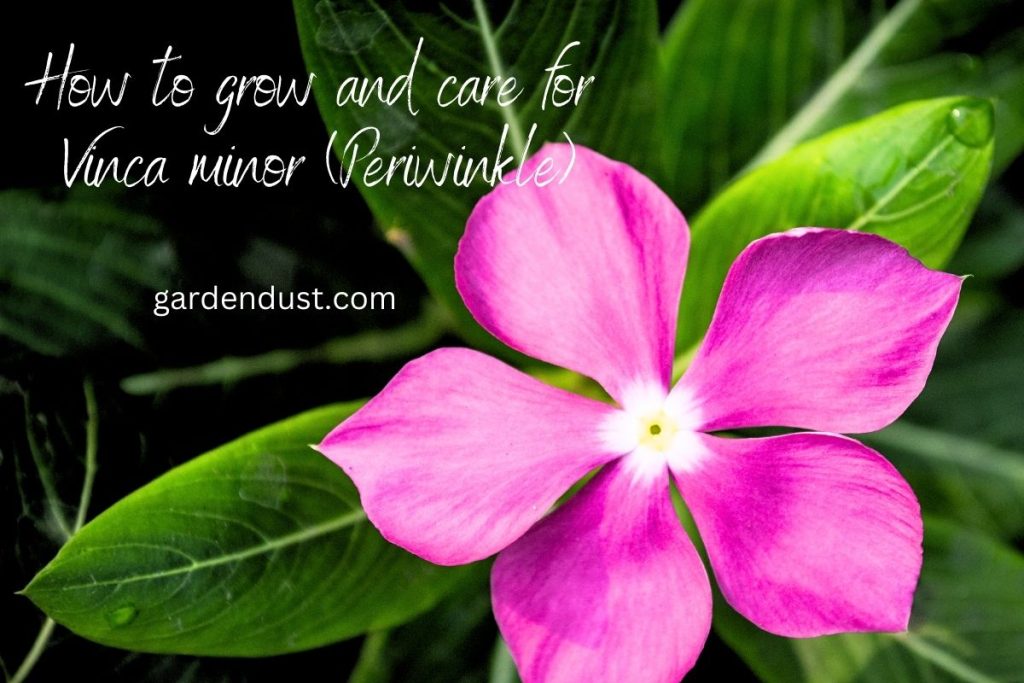Periwinkle flowers are popular in gardens and can be used as ground cover or as a border plant. They are also used in traditional medicine to treat a variety of ailments, including cancer, diabetes, and high blood pressure. However, it is important to note that some parts of the plant are toxic and should not be ingested without the supervision of a qualified healthcare professional.
| Family | Apocynaceae |
| Native | Europe |
| Botanical Name | Vinca minor |
| Common Name | Vinca, myrtle, lesser periwinkle, dwarf periwinkle, Vinca minor, periwinkle |
| Flowers Colors | Blue, Lavender, Violet, White, Pink |
Periwinkle Plant –
Periwinkle flowers are herbaceous plants, which means they have soft and non-woody stems. They are perennial, meaning they live for more than two years, and can grow up to 6-18 inches tall.
Periwinkle flowers –
Plant have five petals that are fused together to form a tubular shape. The center of the flower has a small, protruding stamen that is surrounded by a ring of white hairs. The leaves of the periwinkle plant are opposite, meaning they grow in pairs on either side of the stem.
The color of the periwinkle flower can vary slightly depending on factors such as soil type, light exposure, and temperature. Overall, periwinkle is known for its beautiful and calming shades of blue and purple.
Benefits of Periwinkle :
Periwinkle flowers have a range of potential benefits and uses, including:
- Traditional medicine: Periwinkle has been used in traditional medicine to treat various health conditions, such as high blood pressure, diabetes, and menstrual pain. Some research suggests that periwinkle may have anti-cancer properties, and it is used in some cancer treatments.
- Mental health: The calming blue and purple hues of periwinkle flowers are said to have a relaxing effect on the mind and body. Some people may use periwinkle as part of aromatherapy or to make natural remedies to help with anxiety and stress.
- Garden and landscaping: Periwinkle flowers are popular in gardens and landscaping as they are low-maintenance, attractive, and can be used as ground cover or border plants.
- Decorative uses: The colorful and delicate flowers of the periwinkle plant can be used for decorative purposes, such as in floral arrangements, wreaths, and bouquets.
It’s important to note that while periwinkle has potential benefits, some parts of the plant can be toxic if ingested. It’s always best to consult with a qualified healthcare professional before using any plant-based remedies or supplements.
Note-Periwinkle flowers, also known as Vinca or Myrtle, are native to Europe and parts of Asia. The plant has been naturalized in many other parts of the world, including North America, where it is often grown as an ornamental plant. In some areas, periwinkle has become invasive and can outcompete native plants, which is why it’s important to be careful when planting periwinkle and to avoid planting it in areas where it could become invasive.
Propagation of Periwinkle:
Periwinkle flowers can be propagated through several methods, including:
- Stem cuttings: Take 4-6 inch long cuttings from the stem of a mature periwinkle plant and remove the leaves from the bottom half of the cutting. Dip the cut end in rooting hormone and plant it in a pot filled with well-draining soil. Keep the soil moist and in a warm, bright location until the cutting develops roots and can be transplanted.
- Division: Periwinkle plants can be divided in the spring or fall when they become too large. Dig up the plant and carefully separate the roots and stems into smaller sections. Replant each section in well-draining soil and water well.
- Seed: Periwinkle plants can be grown from seed, but it can be a slower and less reliable method of propagation. Sow seeds in the spring or fall in a pot filled with well-draining soil, cover lightly with soil, and keep the soil moist. The seedlings can be transplanted once they are large enough to handle.
Regardless of the propagation method used, it’s important to keep the soil moist but not waterlogged, and to provide the plant with plenty of light and good drainage. With proper care, periwinkle flowers can be a beautiful addition to any garden or landscape.
Care of Periwinkle:
Periwinkle flowers are relatively low-maintenance plants, but they do require some care to thrive. Here are some tips for caring for periwinkle flowers:
- Light: Periwinkle flowers prefer full sun to partial shade, but can also grow in shade. Provide them with at least 4-6 hours of direct sunlight per day.
- Water: Water periwinkle flowers regularly to keep the soil moist, but not waterlogged. Be careful not to overwater, as this can cause root rot.
- Soil: Periwinkle flowers prefer well-draining soil that is rich in organic matter. If the soil is heavy and clay-like, mix in some sand or perlite to improve drainage.
- Fertilizer: Periwinkle flowers do not require fertilizer, but you can apply a slow-release fertilizer once or twice a year to encourage growth and flowering.
- Pruning: Periwinkle flowers benefit from regular pruning to keep them from becoming too leggy or overgrown. Prune back the stems in the spring or fall to promote bushier growth.
- Pests and diseases: Periwinkle flowers are relatively resistant to pests and diseases, but they can be susceptible to root rot, powdery mildew, and aphids. To prevent these issues, make sure the soil is well-draining, avoid overhead watering, and keep the plant healthy with proper watering and pruning.
Overall, periwinkle flowers are relatively easy to care for and can add a beautiful pop of color to any garden or landscape. Happy Gardening….







